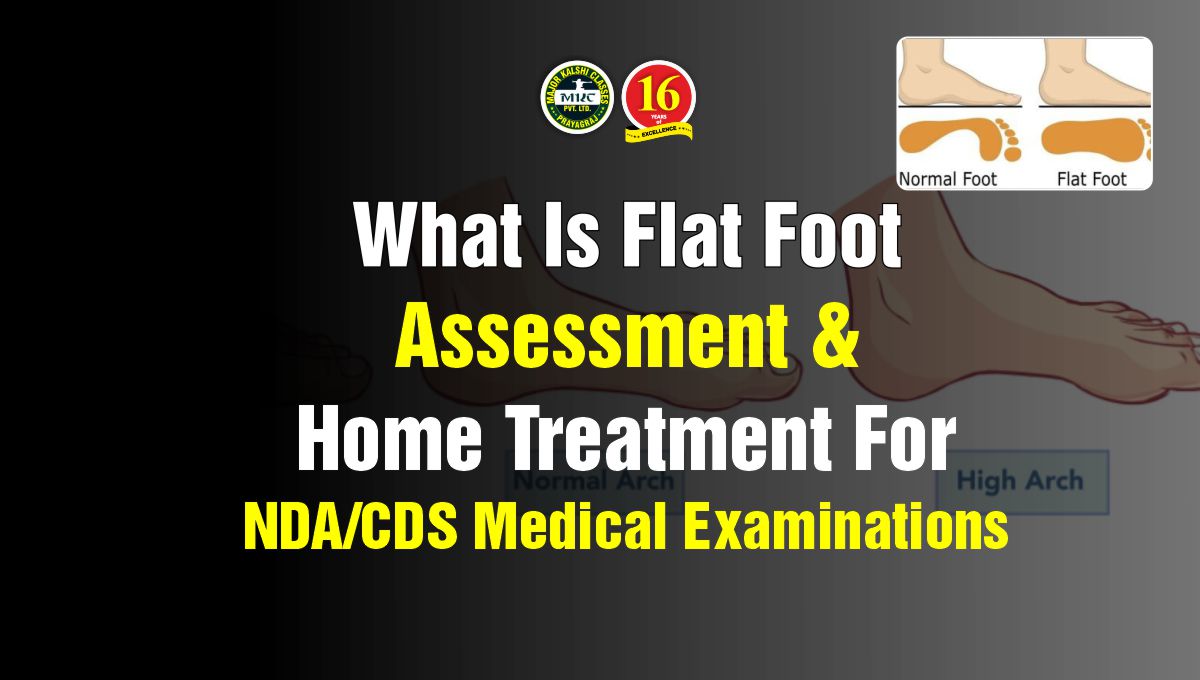What is Flat Foot: Assessment and Home Treatment for NDA/CDS Medical Examinations
Flat foot, also known as pes planus or fallen arches, is a common condition characterized by the reduced or absent arches of the feet. In the context of medical examinations for organizations like the National Defence Academy (NDA) and Combined Defence Services (CDS), understanding flat foot and its evaluation becomes crucial. This article aims to provide insights into flat foot, outline methods for checking the condition, and suggest home-based treatment options to address flat foot in preparation for NDA/CDS medical examinations.
What is Flat Foot
Fallen arches is categorized as either flexible or rigid. In flexible flat foot, the arch appears when the foot is lifted off the ground, but flattens when weight is placed on it. Rigid flat foot, on the other hand, maintains a flattened arch regardless of weight-bearing. The condition can be congenital or acquired due to factors such as genetics, muscle or tendon abnormalities, trauma, or certain medical conditions.
Checking for Flat Foot
- Wet Foot Test: Wet the sole of your foot and stand on a surface that will leave a visible footprint, such as a piece of paper or a towel. If the footprint shows the entire sole or a large part of it, with minimal arch curvature, it may indicate flat foot.
- Visual Examination: While standing, observe the inner arch of your foot. If it appears low or flattened, it could be an indicator of fallen arches.
- Pain or Discomfort: Pay attention to any pain, discomfort, or fatigue experienced in the feet, ankles, or lower legs. These symptoms can be associated with flat foot and may warrant further evaluation.
Treating Flat Foot at Home
- Supportive Footwear: Opt for well-fitting shoes that provide adequate arch support and cushioning. Look for shoes with features designed to support flat feet, such as built-in arch support and stability features. Additionally, consider using orthotic inserts or insoles for additional support and to promote proper foot alignment.
- Foot Strengthening Exercises: Perform exercises that target the muscles and ligaments supporting the arches of the feet. Examples include toe curls, arch lifts, and picking up marbles with your toes. These exercises help strengthen the foot muscles and improve overall foot stability. Consult a physical therapist or podiatrist for specific exercises tailored to your condition.
- Stretching and Massage: Stretching exercises for the calf muscles, Achilles tendon, and plantar fascia can help alleviate symptoms associated with fallen arches. Self-massage techniques using a tennis ball or rolling your foot over a frozen water bottle can also provide relief and increase flexibility.
- Weight Management: Maintaining a healthy weight is important, as excess weight can put additional strain on the feet. Focus on a balanced diet and engage in regular physical activity to manage weight effectively.
- Rest and Ice: If you experience pain or discomfort in the feet or lower legs, allow for sufficient rest and apply ice packs to the affected area to reduce inflammation and relieve symptoms.
Seeking Professional Guidance
While these home treatment options can provide relief for mild to moderate cases of fallen arches, severe or persistent symptoms may require professional intervention. It is advisable to consult with a medical professional, preferably an orthopedic specialist or podiatrist, for a comprehensive evaluation, personalized treatment recommendations, and to assess your eligibility for NDA/CDS based on the specific medical requirements.
You can visit Major Kalshi Healthcare Centre for the complete treatment of fallen arches.
Understanding flat foot and its assessment is essential for individuals preparing for NDA/CDS medical examinations. While home-based treatment options can provide relief, it is important to consult with a healthcare professional for a thorough evaluation and guidance tailored to your specific condition. By following appropriate self-care measures and seeking professional guidance when needed, individuals can effectively manage flat foot, alleviate symptoms, and increase their chances of meeting the medical standards required for NDA/CDS.








